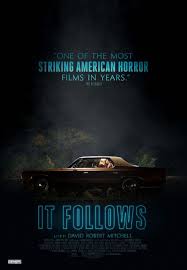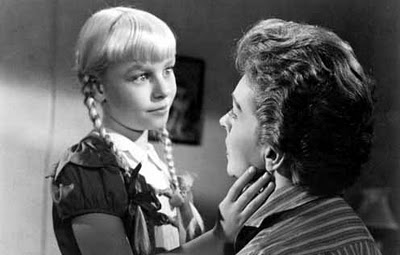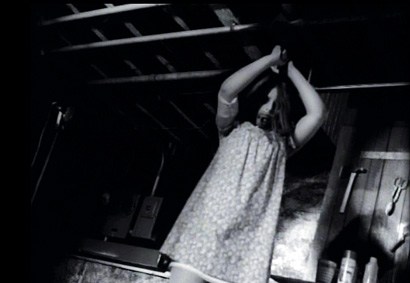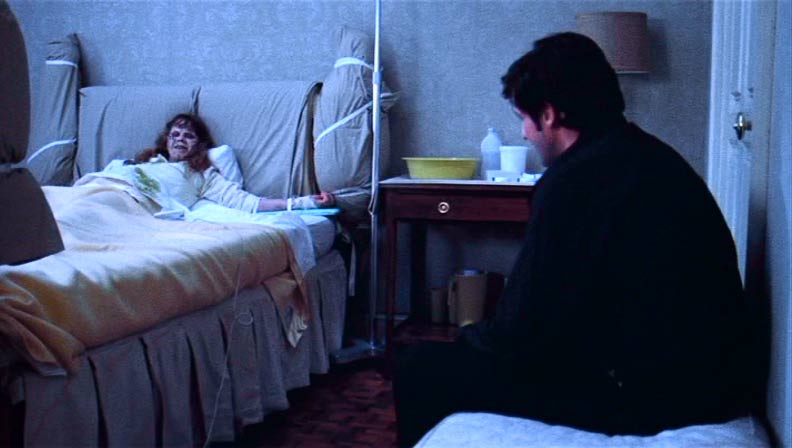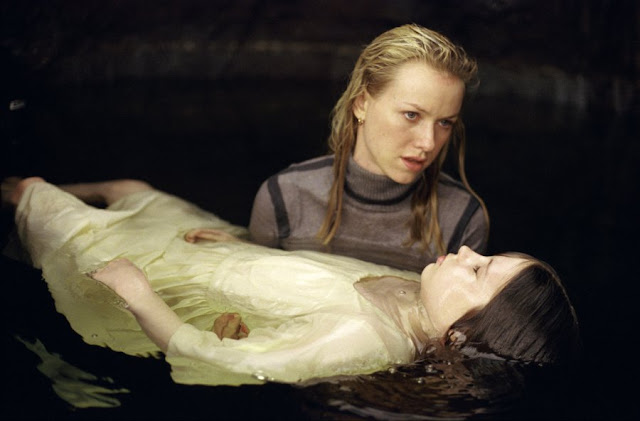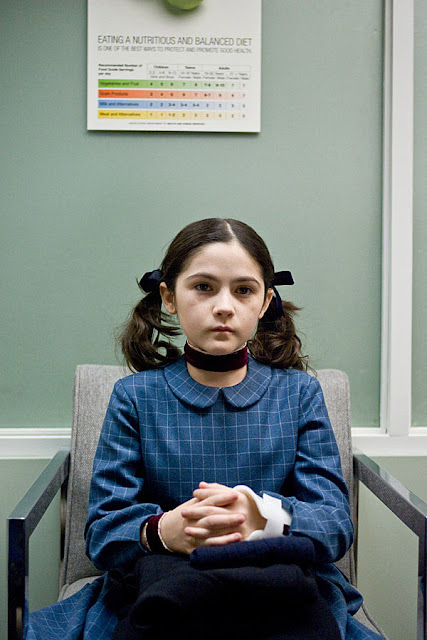Written by Lisa Bolekaja.
It Follows answered the question I was curious to know in the first seven minutes.
“What happens to you after it follows and catches you?” Short answer: you get jacked up. I’ve said this on Twitter and I will say it again here. I sincerely apologize to my fellow viewing audience for laughing with great joy after the first victim is killed. I do have home training. But I was giddy.
We are introduced to an unknown young woman, visibly anxious as she runs out of her family home wearing flimsy underwear and heels in the middle of the night. It’s like we caught her in a state of undress after a long day at work, or maybe after a date, but we never know because there is a great 360-degree camera pan that sets the tone for the rest of the film. The writer/director David Robert Mitchell is forcing the audience to not trust anything or anyone that moves within eyesight. The 360 camera turns are used to great effect numerous times in this film which creates a relentless creeping dread. We never see what kills our first victim, but we do view the aftermath, and it ain’t pretty. While the audience I was with had a collective “Oh shit” moment after gazing upon the unnaturally twisted remains, I laughed with giddiness because I was now fully engaged. The discordant sound design and music score added to the atmosphere of this slow deliberate terror. Imagine if Portishead had made a horror soundtrack without any singing. It caught my attention, and held it for the first half of the film.
Disclosure: I am a horror connoisseur.
This is a blessing and a curse. It’s a blessing because I’ve enjoyed horror from across the globe and from every era. (I even enjoy bad horror. Stinkers can be a lot of fun to hate watch. I relish it.) It’s also a terrible curse because as hardcore as I am, it’s hard to impress me. I radiate so much joy whenever a new horror film comes out, but then I am quickly disappointed when it doesn’t live up to the hype. Granted, It Follows has a lot of hype surrounding it (“The scariest movie to come out in 10 years!” is a recent example), but most of the overblown hyperbole is because horror, in particular American Horror, is in a sad state of affairs. Overused tropes, clichéd jump-scares, little to no character development, plus sequel after goddamned sequel has stifled the genre. (Don’t get me started on re-makes.) So anything that looks a wee bit fresh and tries to be serious is pounced on as the next great thing. And alas, many filmmakers don’t respect horror. There, I said it. A lack of respect has given rise to a collection of recent horror films that are mediocre at best and straight trash at its worst.
It Follows in those first seven minutes made me believe there is some hope for us jaded Horror Hounds. It’s not the best horror movie I’ve seen, but it’s a decent flick that can be added to the pantheon of solid fares to check out this year. Many of my horror comrades hated it or were disappointed, but I encourage everyone to see it just for the masterful use of dread instead of the usual one-note slasher or gore-riddled bloodfests that are passed off as great horror cinema. The genre I love is more concerned with spectacle rather than genuine fear. (Remember all the Saw sequels that just gave us diminishing returns each time out? Yawn.)
What makes It Follows click on all cylinders in the first half is the empathy we have for our protagonist Jay (Maika Monroe). She reminded me of the classic old school white female heroines in the mold of Sissy Spacek or Jamie Lee Curtis. The set designs, the cars, and even the hairstyles have a retro 70s feel. The color scheme looked slightly muted, a little drab, and this added a dark texture to the film that takes place in Detroit. The mentions of 8 Mile and the demarcation line separating white Detroit and Black Detroit are quite evident. One of the characters talked of her parents warning her about crossing over that implicit physical/racial line due to safety concerns. Just as there is a transgression of the division between the supernatural seeping into the natural world, there is a definite class transgression between rich and poor (and the inferred racial one between Black and white).
What draws us to Jay is her longing to be loved and to have a boyfriend. She’s pretty much a dreamy-eyed plain Jane, but she spruces up quite nicely when she goes on a date with Hugh who uses the alias Jeff (Jake Weary), and this is where her troubles begin. What Jay doesn’t know is that Hugh is slumming with her. Pretending to be interested in Jay for companionship, Hugh has transgressed class lines. He uses the lower class Jay to save himself from the unknown entity that stalks his upper class suburban landscape.
After some hot sweaty sex in the backseat of Hugh/Jeff’s car (which she initiated), Jay eventually finds herself tied to a wheelchair still in her underwear from the afterglow of lovemaking. Hugh/Jeff quickly runs down what her fate will now be. Apparently fucking the wrong person in this world will give you something worse than an STD or AIDS. You now get the unwanted attentions of an “It” that will literally follow you around. And this It can be anyone you know or don’t know. It takes on the embodiment of anyone in order to get close to its intended next victim. Hugh/Jeff tells Jay that the only way to get rid of It is to have sex with someone else, passing on the creeping dread to them. This all smells of the influence of The Ringu Virus films and all the superior J-Horror/K-Horror that the U.S. has ripped off and repackaged. However, I respect David Robert Mitchell’s attempt to spin an oldie but a goodie into something new. The catch is, if you pass It onto someone else, and they get killed before they have sex with a new partner–Surprise!—It will come back after you. Ain’t that a bitch? This menace is truly relentless and inescapable.
Our emotionally bamboozled protagonist enlists the help of her younger sister and a rag tag bunch of friends to survive. This is what made the film work for me overall. Her friends are just regular teens, no snarky, overly beautiful, or unrealistic characterizations. Just awkward young people yearning to help her. They know something has gone horribly wrong in Jay’s life. They presumed a date rape, but when Jay tells them her new reality, they don’t shine her on or call her crazy, they support her even when they don’t fully believe in the supernatural weirdness. All of this works well, especially when Jay is the only one who can see It –random strangers of all ages, with pale flaccid faces (sometimes naked) , making slow and eerie movements towards her no matter where she goes. Much like many Asian horror flicks, the beauty of It Follows is that nothing is explained and we don’t waste time trying to figure out the mystery of how it all started. Jay either has to have sex knowing she’s dooming another life or forever be haunted until her own death. She eventually gives in to a form of protective weaponized sex that isn’t degrading. The teens-having- sex-and-then-dying trope (Ahem, Halloween and Friday the 13th) is subverted into something new and dilemma-inducing.
Unfortunately, all promising starts often fizzle out, and halfway through the film the plot lost steam for me. There is some elaborate scheme to try and stop It, but the execution of said scheme doesn’t quite make sense. I also felt that some of the rules of the world got jettisoned, which led to a lackluster ending. There’s nothing wrong with open-ended finales, but I was bored the last 20 minutes, mainly due to the loss of character/plot momentum.
Love it or hate it, It Follows is a thoughtful addition to the horror genre. Hopefully David Robert Mitchell has more dread-inducing gems up his sleeve. But please, no sequels.
See also at Bitch Flicks: An interview with David Robert Mitchell and Maika Monroe
Staff Writer Lisa Bolekaja enoys watching classic Horror Films when they play at the Hollywood Forever Cemetery in the summer. Co-Host of Hilliard’s Guess’ Screenwriting Rant Room Podcast, and a story editor for Apex Magazine, Lisa’s newest short story “Three Voices” comes out next month in Uncanny Magazine.
